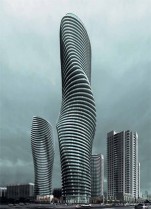Different Approach to the Aerodynamic Performance of Tall Buildings

This paper examines the use of Fluid-based Aerodynamic Modification (FAM) methods derived from flow control techniques first developed for the aerospace industry. Instead of relying on the adjustment of the solid material within the structure to improve the aerodynamics of a tall building, fluid based active flow control is added to the building systems’ matrix to manipulate the building boundary layer and achieve a desired performance for both the interior and exterior. Experimental results are presented to demonstrate proof of concept for the FAM approach to tall building aerodynamic modification.
Introduction
While our environment consists mostly of fluids, we have primarily restricted ourselves to approaching investigations of the interactions between buildings and their surroundings by using solid modeling. As a result, the design of tall buildings has relied on both a Solid-based Aerodynamic Modification (SAM) approach to meet a desired aerodynamic performance and techniques to modify the geometry of the building (Geometry-based Aerodynamic Modification or GAM) or its structural properties, such as stiffness through the use of materials and auxiliary damping systems. Although these techniques do provide a narrow path for success, they do not adapt to fluctuating environmental conditions and are accompanied by a loss of useful floor area and an increase in total energy cost.
SAM for Cross Wind Response Reduction
The development and increasing use of light-weight and high-strength materials in the construction of tall buildings, offering greater flexibility and reduced damping, has increased tall building susceptibility to dynamic wind load effects (Li et al. 2011) that limit the gains afforded by incorporating these new materials. The main associated risk is resonant oscillations induced by von-Kármán-like vortex shedding at or near the natural frequency of the structure caused by flow separation. The effects of dynamic wind loading increase proportionally with the power of the wind, causing tall buildings to pay a significant material price to increase the natural frequency and/or provide damping. In particular, crosswind response often governs both the strength and serviceability (human habitability) design criteria.
While both SAM and GAM strategies have merit, they often come at the expense of valuable leasable area and high construction costs, due to increased structural requirements for mass and stiffness, further contributing towards the high consumption of non-renewable resources by the building sector. Therefore, a traditional aerodynamic based solution comes at the cost of habitable, and therefore valuable, floor area that, in turn, may require additional compensatory stories, which further increase the wind loads and construction costs (Tse et al. 2009).
Full content of this issue you can read here
The full version of the article can be read in our printed issue, also you can subscribe to the web-version of the magazine
 Materials is courtesy of CTBUH and David Menicovich
Materials is courtesy of CTBUH and David Menicovich


